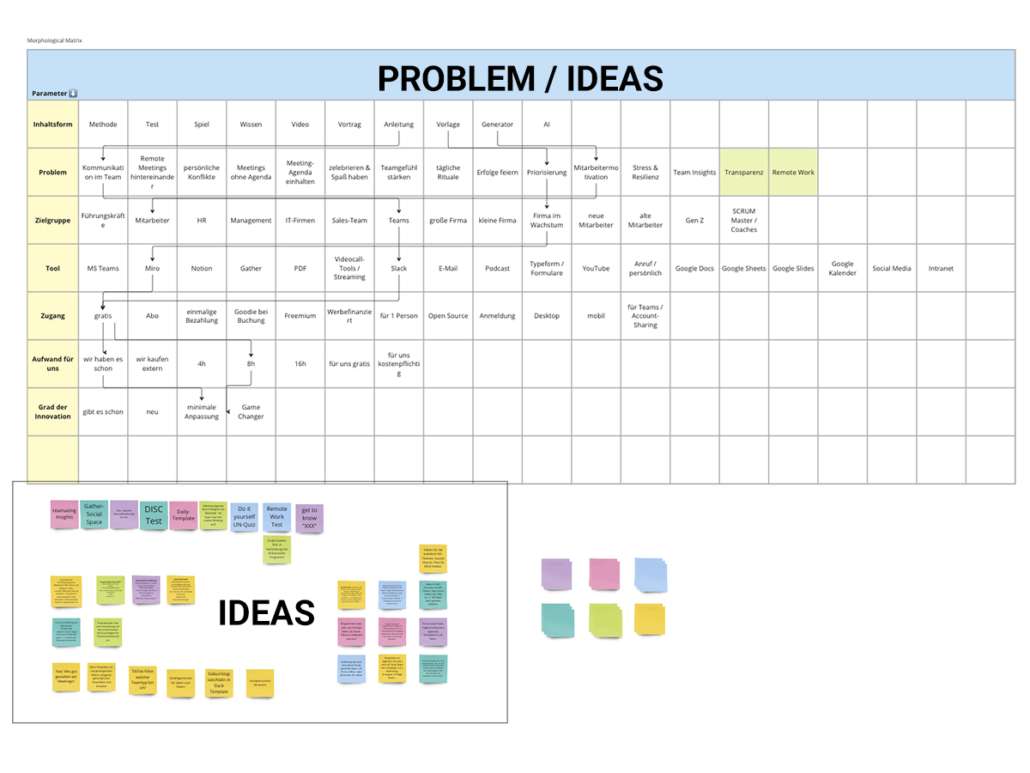Teams are the driving force behind any successful project, and the key to their success lies in their ability to innovate and think creatively. However, coming up with new ideas can be a daunting task, and even the most talented teams can struggle with idea generation. Begs the question: How to combat this problem, and rekindle the creative fire within your team? The answer may be a morphological matrix. Let’s explain.
Morphological Matrix Definition
A morphological matrix is a tool used to generate ideas by breaking down complex problems into smaller components. It consists of a table or grid with different categories, each of which represents a component of the problem. The morphological matrix is a key concept within morphological analysis. By combining different elements from each category, new ideas can be generated. All in all, the model can pose as a key asset in your next team meeting, kick-off event or brainstorming session. Let’s look at an example.
Example:
In the 1990s, Lego was facing declining sales and struggling to come up with new and innovative products. In an effort to turn things around, the company decided to use a morphological matrix to generate new product ideas. Lego’s morphological matrix consisted of different categories, including color, theme, and functionality. The team members were encouraged to brainstorm ideas for each category and combine them in various ways to come up with new and innovative product concepts.
Using the morphological matrix, the Lego team was able to generate a wide range of new product ideas, including themed sets, multi-functional blocks, and interactive playsets. They were able to break down complex problems into smaller components and explore different combinations of solutions, leading to more creative and innovative ideas.
The success of Lego’s morphological matrix is evident in the company’s current standing as one of the world’s most successful and innovative toy companies. By using the morphological matrix to generate new and innovative product ideas, Lego was able to turn around its declining sales and position itself as a leader in the industry.
Background

Illustration of Fritz Zwicky, as father of general morphology.
The morphological matrix was first developed by Swiss scientist Fritz Zwicky in the 1940s as a way to solve complex problems in the field of astronomy. Zwicky realized that by breaking down a problem into smaller components, he could generate more ideas and solutions. He developed the morphological matrix as a way to organize these different components and combine them in various ways to create new solutions.
Since then, the morphological matrix has been used in a variety of fields and industries, including product design, marketing, and engineering. It has become a popular tool for teams looking to enhance their creativity, innovation and collaboration, and is often used in brainstorming sessions to generate new ideas.
One reason for the morphological matrix’s popularity is its ability to encourage collaboration and cross-functional thinking. By breaking down a problem into different components, team members are encouraged to bring their unique perspectives and expertise to the table. This can lead to more innovative solutions that take into account a wider range of factors and considerations.
Morphological Matrix Benefits
The beauty of the morphological matrix lies in its ability to break down complex problems into manageable pieces. This makes it easier for teams to generate ideas and solutions that they may not have thought of otherwise. It also encourages collaboration and creativity by allowing team members to combine their individual perspectives and expertise.
Another benefit of the morphological matrix is its versatility. It can be used in a wide range of industries and settings, from product design to marketing campaigns to problem-solving in the workplace. Its adaptability makes it a valuable tool for teams in any field.
In addition to generating new ideas, the morphological matrix can also help teams to refine and improve existing ideas. By breaking down a concept into its different components, teams can identify areas for improvement and find ways to enhance the overall design. We love adding fun concepts like these to our meetings. Not only because it is a creative way to generate ideas, but also because it breaks up long boring meetings, just like break-out discussions, ice breakers etc.
Overall, a morphological matrix is a powerful tool that can help teams enhance their creativity and innovation. By breaking down complex problems into manageable pieces, teams can generate new and innovative ideas that they may not have thought of otherwise. Its versatility makes it a valuable tool for teams in any industry, and its ability to encourage collaboration and creativity is invaluable for any team looking to achieve success, especially for the following:
In conclusion, if you’re looking for a way to enhance creativity and innovation within your team, consider incorporating a morphological matrix into your brainstorming process. By breaking down complex problems into smaller components, the morphological matrix can help your team generate new ideas and refine existing ones. So go ahead and give it a try – you might just be surprised by the amazing ideas that your team comes up with!
Morphological Matrix Free Template
We at teamazing frequently use our morphological matrix when we encounter problems that just simply seem unsolvable. It is an integral part of many of our team meetings, especially when brainstorming new projects, ideas or products. However, as you probably have gathered from the text, the principle of the morphological matrix can be applied to almost any situation. That’s why we decided to share the template for our morphological box on Miro with you.
To use our template, simply add it as a favorite in your own Miro workspace. Then, click on the board name in the top left and select “duplicate”. Congrats, now you can share the board with your whole team!
You might also be interested in: How to create Mindmaps
VIDEO: How to use a morphological matrix
FAQs Morphological Matrix
Why is it called a morphological matrix?
Great question. Morphology is rooted in linguistics, and is the study of words and their structure. The focus of the morphological matrix is essentially to try out the combination of different words, phrases and their forms.
Are there any limitations of the morphological matrix?
Of course, also this model has its limitations and cannot be applied to every situation. Not every problem can be simplified and, therefore, be easily visualized in a morphological matrix.




